Pricing Guides & Dictionary of Makers Marks for Antiques & Collectibles

A few examples of appraisal values for
STONE AXE
Search our price guide for your own treasures
-
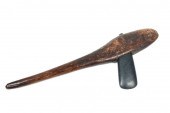 PRIMITIVE STONE AXE - Basalt Head
PRIMITIVE STONE AXE - Basalt Head Axe with loose hafted large shaped handle Highland of Arian Jaya Western New Guinea for splitting wood 11 1/4'' long stone head 29'' long handle wear from use.
PRIMITIVE STONE AXE - Basalt Head
PRIMITIVE STONE AXE - Basalt Head Axe with loose hafted large shaped handle Highland of Arian Jaya Western New Guinea for splitting wood 11 1/4'' long stone head 29'' long handle wear from use. -
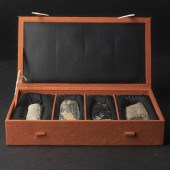 A Group of Four Archaic
A Group of Four Archaic Ceremonial Stone Axes, Neolithic Period (Circa 6500-1700 BC) ????? ?????? Thick stone axes with beveled cutting edges largest length 4.3 in — 11 cm
A Group of Four Archaic
A Group of Four Archaic Ceremonial Stone Axes, Neolithic Period (Circa 6500-1700 BC) ????? ?????? Thick stone axes with beveled cutting edges largest length 4.3 in — 11 cm -
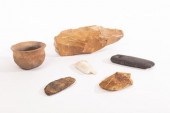 A collection of Neolithic tools,
A collection of Neolithic tools, comprising a polished trapezoid axe head, probably Danish, 8.5cm, another axe head in basalt, 13.8cm, a Mesolithic axe head, 10.5cm, a flat blade or scraper, 11cm, and a large Neolithic flint core, 5000-2500 BC, probably from Le Grand-Pressigny, worked all over with the removal of numerous flakes, 22.5cm long, together with a Bronze Age style pottery beaker, 10.5cm, origin unknown although said to be from Shropshire (6)/Provenance: from the Henry Sandon Study Col
A collection of Neolithic tools,
A collection of Neolithic tools, comprising a polished trapezoid axe head, probably Danish, 8.5cm, another axe head in basalt, 13.8cm, a Mesolithic axe head, 10.5cm, a flat blade or scraper, 11cm, and a large Neolithic flint core, 5000-2500 BC, probably from Le Grand-Pressigny, worked all over with the removal of numerous flakes, 22.5cm long, together with a Bronze Age style pottery beaker, 10.5cm, origin unknown although said to be from Shropshire (6)/Provenance: from the Henry Sandon Study Col -
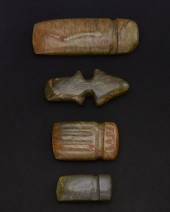 A GROUP OF CARVED STONE AXESA group
A GROUP OF CARVED STONE AXESA group of carved stone axes, Pre-historic or later Comprising four large ax heads of a dark green striated stone, the largest with a snake motif to each side, 4 pieces Largest: 4" H x 11.25" L x 1.5" W Provenance: The James M. Cole Collection, Visalia, CA Dimensions: Largest: 4" H x 11.25" L x 1.5" W Provenance: The James M. Cole Collection, Visalia, CA
A GROUP OF CARVED STONE AXESA group
A GROUP OF CARVED STONE AXESA group of carved stone axes, Pre-historic or later Comprising four large ax heads of a dark green striated stone, the largest with a snake motif to each side, 4 pieces Largest: 4" H x 11.25" L x 1.5" W Provenance: The James M. Cole Collection, Visalia, CA Dimensions: Largest: 4" H x 11.25" L x 1.5" W Provenance: The James M. Cole Collection, Visalia, CA -
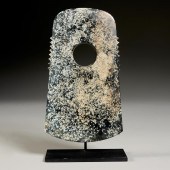 ARCHAIC STYLE CHINESE HARDSTONE
ARCHAIC STYLE CHINESE HARDSTONE RITUAL OBJECT Possibly c. 2000 BCE, axe shaped ceremonial object with saw-tooth edge and central circular opening, on museum mount, 9.25"h x 5.5"w (stone), 10.5"h (with stand)
ARCHAIC STYLE CHINESE HARDSTONE
ARCHAIC STYLE CHINESE HARDSTONE RITUAL OBJECT Possibly c. 2000 BCE, axe shaped ceremonial object with saw-tooth edge and central circular opening, on museum mount, 9.25"h x 5.5"w (stone), 10.5"h (with stand) -
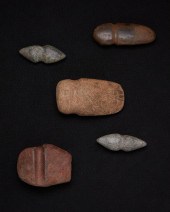 A GROUP OF CARVED STONE AXESA group
A GROUP OF CARVED STONE AXESA group of carved stone axes, Pre-historic or later Comprising axes of various sizes and stones, 5 pieces Largest: 3.5" H x 6" L x 1.75" W Provenance: The James M. Cole Collection, Visalia, CA Dimensions: Largest: 3.5" H x 6" L x 1.75" W Provenance: The James M. Cole Collection, Visalia, CA
A GROUP OF CARVED STONE AXESA group
A GROUP OF CARVED STONE AXESA group of carved stone axes, Pre-historic or later Comprising axes of various sizes and stones, 5 pieces Largest: 3.5" H x 6" L x 1.75" W Provenance: The James M. Cole Collection, Visalia, CA Dimensions: Largest: 3.5" H x 6" L x 1.75" W Provenance: The James M. Cole Collection, Visalia, CA -
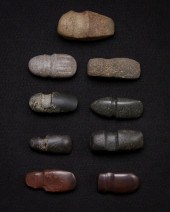 A GROUP OF CARVED STONE GROOVED
A GROUP OF CARVED STONE GROOVED AXESA group of carved stone grooved axes, Pre-historic or later Comprising a group of ax heads in various stones, shapes and sizes, 9 pieces Largest: 2.5" H x 5" L x 2.5" W Provenance: The James M. Cole Collection, Visalia, CA Dimensions: Largest: 2.5" H x 5" L x 2.5" W Provenance: The James M. Cole Collection, Visalia, CA
A GROUP OF CARVED STONE GROOVED
A GROUP OF CARVED STONE GROOVED AXESA group of carved stone grooved axes, Pre-historic or later Comprising a group of ax heads in various stones, shapes and sizes, 9 pieces Largest: 2.5" H x 5" L x 2.5" W Provenance: The James M. Cole Collection, Visalia, CA Dimensions: Largest: 2.5" H x 5" L x 2.5" W Provenance: The James M. Cole Collection, Visalia, CA -
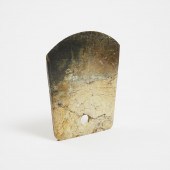 A Liangzhu Neolithic-Style
A Liangzhu Neolithic-Style Hardstone Axe ?????? length 8.4 in — 21.4 cm
A Liangzhu Neolithic-Style
A Liangzhu Neolithic-Style Hardstone Axe ?????? length 8.4 in — 21.4 cm -
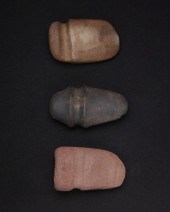 A GROUP OF LARGE CARVED STONE AXESA
A GROUP OF LARGE CARVED STONE AXESA group of large carved stone axes, Pre-historic or later Comprising three large ax heads of various stones and shapes, 3 pieces Largest: 4.75" H x 8.5" L x 3" W Provenance: The James M. Cole Collection, Visalia, CA Dimensions: Largest: 4.75" H x 8.5" L x 3" W Provenance: The James M. Cole Collection, Visalia, CA
A GROUP OF LARGE CARVED STONE AXESA
A GROUP OF LARGE CARVED STONE AXESA group of large carved stone axes, Pre-historic or later Comprising three large ax heads of various stones and shapes, 3 pieces Largest: 4.75" H x 8.5" L x 3" W Provenance: The James M. Cole Collection, Visalia, CA Dimensions: Largest: 4.75" H x 8.5" L x 3" W Provenance: The James M. Cole Collection, Visalia, CA -
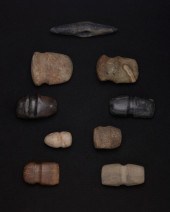 A GROUP OF CARVED STONE AXESA group
A GROUP OF CARVED STONE AXESA group of carved stone axes, Pre-historic or later Comprising carved stone ax heads of various stones, sizes and forms, 9 pieces Largest: 4" H x 4.75" L x 1.75' W Provenance: The James M. Cole Collection, Visalia, CA Dimensions: Largest: 4" H x 4.75" L x 1.75' W Provenance: The James M. Cole Collection, Visalia, CA
A GROUP OF CARVED STONE AXESA group
A GROUP OF CARVED STONE AXESA group of carved stone axes, Pre-historic or later Comprising carved stone ax heads of various stones, sizes and forms, 9 pieces Largest: 4" H x 4.75" L x 1.75' W Provenance: The James M. Cole Collection, Visalia, CA Dimensions: Largest: 4" H x 4.75" L x 1.75' W Provenance: The James M. Cole Collection, Visalia, CA -
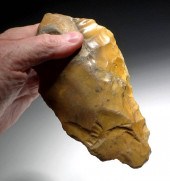 STONE AGE ACHEULEAN HOMO ERECTUS
STONE AGE ACHEULEAN HOMO ERECTUS FLINT HAND AXENorthwestern Europe, Southeast England, Middlesex, Lower Paleolithic, Acheulean period, ca. 400,000 to 250,000 years ago. A superb flint bifacial hand axe was fashioned by Homo erectus (H. heidelbergensis), the first humans to occupy Europe. It dates back to the Lower Paleolithic Period, made in the Acheulian Tradition, and was the predominant tool technology of the Homo erectus people in Europe from 1 million years ago to possibly as recent as 130,000 years ago. Fine quality English Lower Paleolithic hand axes like this, are legendary among collectors and are harder to find since many were found long ago in the early 20th century and many in the 19th century when open gravel pits were commonly dug during the industrial age of England. Most of the finest known European hand axes in major museums hail from these former English gravel pits. English Lower Paleolithic hand axes often move from one private collection to the next as many sites are now destroyed, built over or protected, and fine specimens such as this axe rarely appear on the market. Size: 7.25" L x 3.75" W (18.4 cm x 9.5 cm) The naturally glossy burial patina and intense golden hue highlight the exceptional flaking. This hand axe features an ingenious, ergonomic grip design, made by extensive flaking and forethought to achieve an ambidextrous design that required a great deal of intelligence and skill to execute. The entire hand axe shows excellent and masterful flaking, a prize of a highly skilled Homo erectus primitive human who once lived in what is now present-day England! Due to the size and heft, it is highly probable this hand axe was used to smash open major bones of all the Ice Age large game animals of the day such as mammoth, bison, horse, and rhino. Provenance: ex-private German collection, formed in the 1970s All items legal to buy/sell under U.S. Statute covering cultural patrimony Code 2600, CHAPTER 14, and are guaranteed to be as described or your money back. A Certificate of Authenticity will accompany all winning bids. We ship worldwide and handle all shipping in-house for your convenience. #175611 Condition: Intact with no repair or restoration. Heavy prehistoric patina and mineral deposits.
STONE AGE ACHEULEAN HOMO ERECTUS
STONE AGE ACHEULEAN HOMO ERECTUS FLINT HAND AXENorthwestern Europe, Southeast England, Middlesex, Lower Paleolithic, Acheulean period, ca. 400,000 to 250,000 years ago. A superb flint bifacial hand axe was fashioned by Homo erectus (H. heidelbergensis), the first humans to occupy Europe. It dates back to the Lower Paleolithic Period, made in the Acheulian Tradition, and was the predominant tool technology of the Homo erectus people in Europe from 1 million years ago to possibly as recent as 130,000 years ago. Fine quality English Lower Paleolithic hand axes like this, are legendary among collectors and are harder to find since many were found long ago in the early 20th century and many in the 19th century when open gravel pits were commonly dug during the industrial age of England. Most of the finest known European hand axes in major museums hail from these former English gravel pits. English Lower Paleolithic hand axes often move from one private collection to the next as many sites are now destroyed, built over or protected, and fine specimens such as this axe rarely appear on the market. Size: 7.25" L x 3.75" W (18.4 cm x 9.5 cm) The naturally glossy burial patina and intense golden hue highlight the exceptional flaking. This hand axe features an ingenious, ergonomic grip design, made by extensive flaking and forethought to achieve an ambidextrous design that required a great deal of intelligence and skill to execute. The entire hand axe shows excellent and masterful flaking, a prize of a highly skilled Homo erectus primitive human who once lived in what is now present-day England! Due to the size and heft, it is highly probable this hand axe was used to smash open major bones of all the Ice Age large game animals of the day such as mammoth, bison, horse, and rhino. Provenance: ex-private German collection, formed in the 1970s All items legal to buy/sell under U.S. Statute covering cultural patrimony Code 2600, CHAPTER 14, and are guaranteed to be as described or your money back. A Certificate of Authenticity will accompany all winning bids. We ship worldwide and handle all shipping in-house for your convenience. #175611 Condition: Intact with no repair or restoration. Heavy prehistoric patina and mineral deposits. -
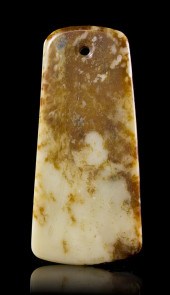 A Mottled Jade Plaque of russet and
A Mottled Jade Plaque of russet and white stone of archaic axe form pierced at one end. Length 7 7/8 inches.
A Mottled Jade Plaque of russet and
A Mottled Jade Plaque of russet and white stone of archaic axe form pierced at one end. Length 7 7/8 inches. -
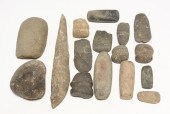 SIXTEEN STONES AND TOOLS. Including
SIXTEEN STONES AND TOOLS. Including grooved axes, celts, grind stones, pestles and hammer stones. Varying wear.
SIXTEEN STONES AND TOOLS. Including
SIXTEEN STONES AND TOOLS. Including grooved axes, celts, grind stones, pestles and hammer stones. Varying wear. -
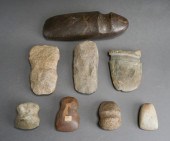 GROUP OF EIGHT ARCHEOLOGICAL
GROUP OF EIGHT ARCHEOLOGICAL STONE AXE HEADSGroup of Eight Archeological Stone Axe Heads,
GROUP OF EIGHT ARCHEOLOGICAL
GROUP OF EIGHT ARCHEOLOGICAL STONE AXE HEADSGroup of Eight Archeological Stone Axe Heads, -
 A Black Stone Hand Axe (Ben),
A Black Stone Hand Axe (Ben), Neolithic Period, Circa 3000 BCE ??????? ?? The smooth polished stone beveled on both ends length 5.2 in — 13.3 cm
A Black Stone Hand Axe (Ben),
A Black Stone Hand Axe (Ben), Neolithic Period, Circa 3000 BCE ??????? ?? The smooth polished stone beveled on both ends length 5.2 in — 13.3 cm -
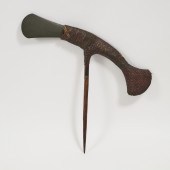 Papua New Guinea Presentation Stone
Papua New Guinea Presentation Stone Axe, Mount Hagen, Western Highlands, 19th century the large slate head on stylized hardwood haft with ornate rattan basketry wrapping length 29.5 in — 74.9 cm
Papua New Guinea Presentation Stone
Papua New Guinea Presentation Stone Axe, Mount Hagen, Western Highlands, 19th century the large slate head on stylized hardwood haft with ornate rattan basketry wrapping length 29.5 in — 74.9 cm -
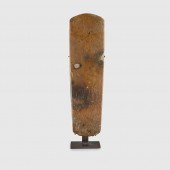 FINE NEOLITHIC FLINT AXE
FINE NEOLITHIC FLINT AXE SCANDINAVIA, C. 3500 B.C. flint, the polished stone displaying a rich honey hue, the cutting edge rounded, raised on a bespoke mount29.3cm tallPrivate collection, United Kingdom
FINE NEOLITHIC FLINT AXE
FINE NEOLITHIC FLINT AXE SCANDINAVIA, C. 3500 B.C. flint, the polished stone displaying a rich honey hue, the cutting edge rounded, raised on a bespoke mount29.3cm tallPrivate collection, United Kingdom -
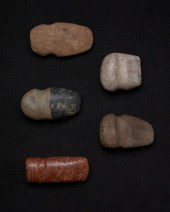 A COLLECTION OF CARVED STONE
A COLLECTION OF CARVED STONE AXESA collection of carved stone axes, Pre-historic or later Comprising a group of ax heads in various stones and shapes, 5 pieces Largest: 3: H x 5.75" L x 2" W Provenance: The James M. Cole Collection, Visalia, CA Dimensions: Largest: 3: H x 5.75" L x 2" W Provenance: The James M. Cole Collection, Visalia, CA
A COLLECTION OF CARVED STONE
A COLLECTION OF CARVED STONE AXESA collection of carved stone axes, Pre-historic or later Comprising a group of ax heads in various stones and shapes, 5 pieces Largest: 3: H x 5.75" L x 2" W Provenance: The James M. Cole Collection, Visalia, CA Dimensions: Largest: 3: H x 5.75" L x 2" W Provenance: The James M. Cole Collection, Visalia, CA -
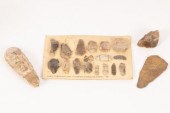 A flint axe head, possibly
A flint axe head, possibly Neolithic, 13cm long, a flint hand axe, 6cm and a mounted card of flint, possible arrows, labelled to the card 'from a Mesolithic site at Foxbury, Hambledon, Surrey, 1937'I/Provenance: The Estate of the late Diana & Gospatric Home, Lily Farm, Bucks
A flint axe head, possibly
A flint axe head, possibly Neolithic, 13cm long, a flint hand axe, 6cm and a mounted card of flint, possible arrows, labelled to the card 'from a Mesolithic site at Foxbury, Hambledon, Surrey, 1937'I/Provenance: The Estate of the late Diana & Gospatric Home, Lily Farm, Bucks -
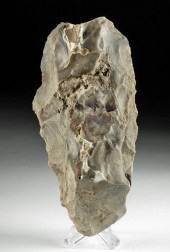 FRENCH NEOLITHIC STONE HAND
FRENCH NEOLITHIC STONE HAND AXEWestern Europe, northern France, Oise department, Hardivillers, Neolithic period, ca. 7000 to 2000 BCE. A lovely hand-knapped chert stone hand axe from the Neolithic period. The axe has a thick butt end which bears a rounded profile and tapers gently towards a sharpened tip. Deep grooves form the rocky yet smooth texture of the implement as the chert displays hues of chalky and ash gray with white and aubergine inclusions. Stone axes like this one would have been used for woodworking or tilling the soil. This knapped axe is part of the technology that marked Neolithic life in northwestern Europe, alongside farming, pottery, and longhouses. Examples of this sort are often found inside of dolmens, large granite blocks that form tombs. Size: 7.6" L x 3.8" W (19.3 cm x 9.7 cm) Provenance: private Lemont, Illinois, USA collection, acquired in the 1980's; ex-J.L. Gasiner collection All items legal to buy/sell under U.S. Statute covering cultural patrimony Code 2600, CHAPTER 14, and are guaranteed to be as described or your money back. A Certificate of Authenticity will accompany all winning bids. We ship worldwide and handle all shipping in-house for your convenience. #176027 Condition: Some nicks and chips to stone, all commensurate with age, but otherwise intact and excellent. Inscription with find site on side as shown.
FRENCH NEOLITHIC STONE HAND
FRENCH NEOLITHIC STONE HAND AXEWestern Europe, northern France, Oise department, Hardivillers, Neolithic period, ca. 7000 to 2000 BCE. A lovely hand-knapped chert stone hand axe from the Neolithic period. The axe has a thick butt end which bears a rounded profile and tapers gently towards a sharpened tip. Deep grooves form the rocky yet smooth texture of the implement as the chert displays hues of chalky and ash gray with white and aubergine inclusions. Stone axes like this one would have been used for woodworking or tilling the soil. This knapped axe is part of the technology that marked Neolithic life in northwestern Europe, alongside farming, pottery, and longhouses. Examples of this sort are often found inside of dolmens, large granite blocks that form tombs. Size: 7.6" L x 3.8" W (19.3 cm x 9.7 cm) Provenance: private Lemont, Illinois, USA collection, acquired in the 1980's; ex-J.L. Gasiner collection All items legal to buy/sell under U.S. Statute covering cultural patrimony Code 2600, CHAPTER 14, and are guaranteed to be as described or your money back. A Certificate of Authenticity will accompany all winning bids. We ship worldwide and handle all shipping in-house for your convenience. #176027 Condition: Some nicks and chips to stone, all commensurate with age, but otherwise intact and excellent. Inscription with find site on side as shown. -
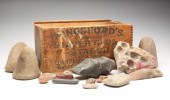 COLLECTION OF TOOLS AND STONES.
COLLECTION OF TOOLS AND STONES. Including grind stones, grooved axe, pestles and other stones. Varying wear.
COLLECTION OF TOOLS AND STONES.
COLLECTION OF TOOLS AND STONES. Including grind stones, grooved axe, pestles and other stones. Varying wear. -
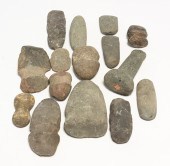 FIFTEEN STONES AND TOOLS. Including
FIFTEEN STONES AND TOOLS. Including grooved axes, celts, grind stones, pestles and hammer stones. Varying wear.
FIFTEEN STONES AND TOOLS. Including
FIFTEEN STONES AND TOOLS. Including grooved axes, celts, grind stones, pestles and hammer stones. Varying wear. -
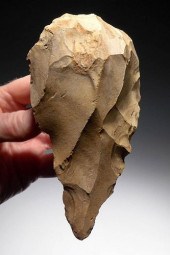 STONE AGE ACHEULEAN ARABIAN
STONE AGE ACHEULEAN ARABIAN PRESTIGE HAND AXEArabian Peninsula, Jordan, Acheulean, ca. 1.2 million to 500,000 years ago. This amazingly rare hand axe was found in an extremely rare location - the Arabian Desert in Jordan in the 1950's by a London collector. Not only is this hand axe in supreme original condition, it shows incredible flaking and form and an extremely thin, bone-piercing pick end that has survived prehistory, unbroken - a true museum-class example! The is unusually bulbous, likely designed as such to allow a firm grip when used, a practical function as it cushioned the blows to the hand when this axe was used in large game butchering tasks. However the workmanship of this tool suggests this was an item of prestige rather than utilitarian. While simple, it represents the first intelligent design type known to science that was made by primitive humans. Prior to these Acheulian tools, only crude pebble tools existed in the human fossil record. Size: 6.5" L x 3.75" W (16.5 cm x 9.5 cm) This is an investment-grade Paleolithic artifact. Specimens like this are one in many, many thousands and are exceptionally rare - this piece is "as found" and original condition. Acheulian hand axes of this quality are rare and recent realized prices at major auction houses are proving what we have been saying for years that authentic high grade tools of primitive man remain one of the most promising investments. Provenance: ex-Bowyer collection, London, UK, found in the 1950s All items legal to buy/sell under U.S. Statute covering cultural patrimony Code 2600, CHAPTER 14, and are guaranteed to be as described or your money back. A Certificate of Authenticity will accompany all winning bids. We ship worldwide and handle all shipping in-house for your convenience. #175612 Condition: Intact and complete, without repair or restoration. Choice bi-color patina from long-term surface exposure on one side.
STONE AGE ACHEULEAN ARABIAN
STONE AGE ACHEULEAN ARABIAN PRESTIGE HAND AXEArabian Peninsula, Jordan, Acheulean, ca. 1.2 million to 500,000 years ago. This amazingly rare hand axe was found in an extremely rare location - the Arabian Desert in Jordan in the 1950's by a London collector. Not only is this hand axe in supreme original condition, it shows incredible flaking and form and an extremely thin, bone-piercing pick end that has survived prehistory, unbroken - a true museum-class example! The is unusually bulbous, likely designed as such to allow a firm grip when used, a practical function as it cushioned the blows to the hand when this axe was used in large game butchering tasks. However the workmanship of this tool suggests this was an item of prestige rather than utilitarian. While simple, it represents the first intelligent design type known to science that was made by primitive humans. Prior to these Acheulian tools, only crude pebble tools existed in the human fossil record. Size: 6.5" L x 3.75" W (16.5 cm x 9.5 cm) This is an investment-grade Paleolithic artifact. Specimens like this are one in many, many thousands and are exceptionally rare - this piece is "as found" and original condition. Acheulian hand axes of this quality are rare and recent realized prices at major auction houses are proving what we have been saying for years that authentic high grade tools of primitive man remain one of the most promising investments. Provenance: ex-Bowyer collection, London, UK, found in the 1950s All items legal to buy/sell under U.S. Statute covering cultural patrimony Code 2600, CHAPTER 14, and are guaranteed to be as described or your money back. A Certificate of Authenticity will accompany all winning bids. We ship worldwide and handle all shipping in-house for your convenience. #175612 Condition: Intact and complete, without repair or restoration. Choice bi-color patina from long-term surface exposure on one side. -
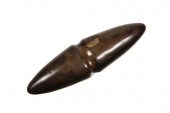 EXCEPTIONAL MESOAMERICAN POLISHED
EXCEPTIONAL MESOAMERICAN POLISHED BLACK STONE NOTCHED PICK AXE-NEOLITHIC ERA - Round in section tapering to a point at each end. L. 6 1/4'' x 1'1/2'' diam. From the Marvin Sadik Collection.
EXCEPTIONAL MESOAMERICAN POLISHED
EXCEPTIONAL MESOAMERICAN POLISHED BLACK STONE NOTCHED PICK AXE-NEOLITHIC ERA - Round in section tapering to a point at each end. L. 6 1/4'' x 1'1/2'' diam. From the Marvin Sadik Collection. -
 Three hand axes, two likely
Three hand axes, two likely Neolithic; multiple chips and flaws, as-is condition; largest item measuring L 5" x 2"Provenance: Collected between 1945-1960 by Carl O. Winberg, former United States Government diplomat, agricultural attache and Foreign Service officer serving across Indonesia, India Burma, Bangladesh and Australia; thence by descent to the present owner.
Three hand axes, two likely
Three hand axes, two likely Neolithic; multiple chips and flaws, as-is condition; largest item measuring L 5" x 2"Provenance: Collected between 1945-1960 by Carl O. Winberg, former United States Government diplomat, agricultural attache and Foreign Service officer serving across Indonesia, India Burma, Bangladesh and Australia; thence by descent to the present owner. -
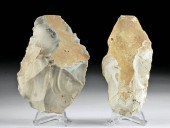 PALEOLITHIC FRENCH STONE AGE
PALEOLITHIC FRENCH STONE AGE ACHEULEAN HAND AXES**Originally Listed At $600** Western Europe, Northern France, Troussencourt & Touvent, Paleolithic, late Oldowan to Acheulean period, ca. 1,000,000 to 40,000 years ago. A pair of chert hand axes from prehistoric peoples- likely the Acheulean period, named after the location in France, where tools of this kind were first identified in 1847. Stone tools such as this were made by Homo erectus or Homo heidelbergensis, close ancestors of modern humans, and used in a variety of tasks -butchering and skinning game, digging in soil, cutting trees and other plant matter. Size: 5.5" L x 3.5" W (14 cm x 8.9 cm) Provenance: private Lemont, Illinois, USA collection, acquired in the 1980's; ex-J.L. Gasiner collection All items legal to buy/sell under U.S. Statute covering cultural patrimony Code 2600, CHAPTER 14, and are guaranteed to be as described or your money back. A Certificate of Authenticity will accompany all winning bids. We ship worldwide and handle all shipping in-house for your convenience. #176030 Condition: Some chips and losses as expected with age to both. Overall great condition. Find sites written on surfaces.
PALEOLITHIC FRENCH STONE AGE
PALEOLITHIC FRENCH STONE AGE ACHEULEAN HAND AXES**Originally Listed At $600** Western Europe, Northern France, Troussencourt & Touvent, Paleolithic, late Oldowan to Acheulean period, ca. 1,000,000 to 40,000 years ago. A pair of chert hand axes from prehistoric peoples- likely the Acheulean period, named after the location in France, where tools of this kind were first identified in 1847. Stone tools such as this were made by Homo erectus or Homo heidelbergensis, close ancestors of modern humans, and used in a variety of tasks -butchering and skinning game, digging in soil, cutting trees and other plant matter. Size: 5.5" L x 3.5" W (14 cm x 8.9 cm) Provenance: private Lemont, Illinois, USA collection, acquired in the 1980's; ex-J.L. Gasiner collection All items legal to buy/sell under U.S. Statute covering cultural patrimony Code 2600, CHAPTER 14, and are guaranteed to be as described or your money back. A Certificate of Authenticity will accompany all winning bids. We ship worldwide and handle all shipping in-house for your convenience. #176030 Condition: Some chips and losses as expected with age to both. Overall great condition. Find sites written on surfaces. -
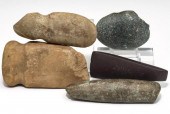 A COLLECTION OF PREHISTORIC STONE
A COLLECTION OF PREHISTORIC STONE TOOLSThe collection of celts and axe heads is offered as shown.Sizes range from 4 to 6.5 inches.The condition is as shown in the images with some being chipped.Provenance: The 40 year collection of Father Tom Wiederholt, Kansas City, Missouri. Tom was a close personal friend of scholar and curator Ralph 'Ted' Coe who advised Tom on most of his acquisitions.
A COLLECTION OF PREHISTORIC STONE
A COLLECTION OF PREHISTORIC STONE TOOLSThe collection of celts and axe heads is offered as shown.Sizes range from 4 to 6.5 inches.The condition is as shown in the images with some being chipped.Provenance: The 40 year collection of Father Tom Wiederholt, Kansas City, Missouri. Tom was a close personal friend of scholar and curator Ralph 'Ted' Coe who advised Tom on most of his acquisitions. -
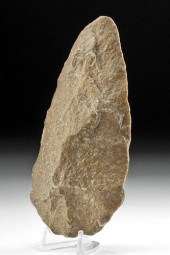 PALEOLITHIC MAURITANIAN ACHEULEAN
PALEOLITHIC MAURITANIAN ACHEULEAN STONE HAND AXEWestern Africa, Mauritania, Lower Paleolithic, Acheulean period, ca. 700,000 to 130,000 years ago. This is a large hand axe made and used by early humans of the species Homo erectus (ergaster) of a bifacial and convex form, hand-knapped from a desert red quartzite. The tool is defined by a thick handle end, sharpened edges, and a broad curved cutting tip. Acheulean hand axes represent some of the earliest tools made by our ancestors, and this example has a surface that is polished to a smooth, almost silky surface from exposure, attesting to the tool's great age. During the time of this axe, there were large elephant and hippopotamus species as well as giraffe species in Africa that primitive humans would have hunted. An axe like this was necessary for butchering such large kills and scraping hides. Size: 6" L x 3" W (15.2 cm x 7.6 cm) Provenance: Whisnant Gallery, New Orleans, Louisiana, USA acquired prior to 2000 All items legal to buy/sell under U.S. Statute covering cultural patrimony Code 2600, CHAPTER 14, and are guaranteed to be as described or your money back. A Certificate of Authenticity will accompany all winning bids. PLEASE NOTE: Due to recent increases of shipments being seized by Australian & German customs (even for items with pre-UNESCO provenance), we will no longer ship most antiquities and ancient Chinese art to Australia & Germany. For categories of items that are acceptable to ship to Australia or Germany, please contact us directly or work with your local customs brokerage firm. Display stands not described as included/custom in the item description are for photography purposes only and will not be included with the item upon shipping. #169682 Condition: Great weathered patina and smooth edges. Intact and excellent. Inventory and description label on one face.
PALEOLITHIC MAURITANIAN ACHEULEAN
PALEOLITHIC MAURITANIAN ACHEULEAN STONE HAND AXEWestern Africa, Mauritania, Lower Paleolithic, Acheulean period, ca. 700,000 to 130,000 years ago. This is a large hand axe made and used by early humans of the species Homo erectus (ergaster) of a bifacial and convex form, hand-knapped from a desert red quartzite. The tool is defined by a thick handle end, sharpened edges, and a broad curved cutting tip. Acheulean hand axes represent some of the earliest tools made by our ancestors, and this example has a surface that is polished to a smooth, almost silky surface from exposure, attesting to the tool's great age. During the time of this axe, there were large elephant and hippopotamus species as well as giraffe species in Africa that primitive humans would have hunted. An axe like this was necessary for butchering such large kills and scraping hides. Size: 6" L x 3" W (15.2 cm x 7.6 cm) Provenance: Whisnant Gallery, New Orleans, Louisiana, USA acquired prior to 2000 All items legal to buy/sell under U.S. Statute covering cultural patrimony Code 2600, CHAPTER 14, and are guaranteed to be as described or your money back. A Certificate of Authenticity will accompany all winning bids. PLEASE NOTE: Due to recent increases of shipments being seized by Australian & German customs (even for items with pre-UNESCO provenance), we will no longer ship most antiquities and ancient Chinese art to Australia & Germany. For categories of items that are acceptable to ship to Australia or Germany, please contact us directly or work with your local customs brokerage firm. Display stands not described as included/custom in the item description are for photography purposes only and will not be included with the item upon shipping. #169682 Condition: Great weathered patina and smooth edges. Intact and excellent. Inventory and description label on one face. -
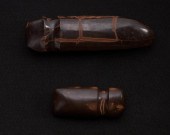 TWO CARVED STONE AXESTwo carved
TWO CARVED STONE AXESTwo carved stone axes, Pre-historic or later Each of a dark brown stone with lighter highlights and veining throughout, 2 pieces Largest: 2.75" H x 10" L x 2.25" W Provenance: The James M. Cole Collection, Visalia, CA Dimensions: Largest: 2.75" H x 10" L x 2.25" W Provenance: The James M. Cole Collection, Visalia, CA
TWO CARVED STONE AXESTwo carved
TWO CARVED STONE AXESTwo carved stone axes, Pre-historic or later Each of a dark brown stone with lighter highlights and veining throughout, 2 pieces Largest: 2.75" H x 10" L x 2.25" W Provenance: The James M. Cole Collection, Visalia, CA Dimensions: Largest: 2.75" H x 10" L x 2.25" W Provenance: The James M. Cole Collection, Visalia, CA -
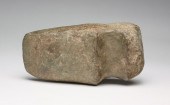 GROOVED AXE. Early stone relic.
GROOVED AXE. Early stone relic. 5.5"l. 2.75"w. 2"d.
GROOVED AXE. Early stone relic.
GROOVED AXE. Early stone relic. 5.5"l. 2.75"w. 2"d. -
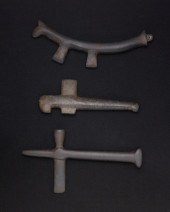 THREE NORTHWEST COAST CARVED
THREE NORTHWEST COAST CARVED STONE AXESThree Northwest Coast carved stone axes, Pre-historic or later Each finely carved from one piece of stone, one with zoomorphic elements and curve to shaft, one with a pipe and ax in a solid black stone, and one with a zoomorphic whale motif and tapered handle, 3 pieces Largest: 16.25" H x 6" W Provenance: The James M. Cole Collection, Visalia, CA Dimensions: Largest: 16.25" H x 6" W Provenance: The James M. Cole Collection, Visalia, CA
THREE NORTHWEST COAST CARVED
THREE NORTHWEST COAST CARVED STONE AXESThree Northwest Coast carved stone axes, Pre-historic or later Each finely carved from one piece of stone, one with zoomorphic elements and curve to shaft, one with a pipe and ax in a solid black stone, and one with a zoomorphic whale motif and tapered handle, 3 pieces Largest: 16.25" H x 6" W Provenance: The James M. Cole Collection, Visalia, CA Dimensions: Largest: 16.25" H x 6" W Provenance: The James M. Cole Collection, Visalia, CA -
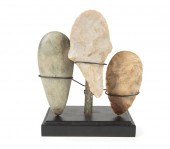 THREE PRE-COLUMBIAN STONE AXE
THREE PRE-COLUMBIAN STONE AXE HEADSThree Pre-Columbian Stone Axe Heads , pre 1500 A.D., incl. greenstone celt, and two flint, tallest h. 6 1/4 in Provenance: Collection of Brooke and Maria Fox, Metairie, LA
THREE PRE-COLUMBIAN STONE AXE
THREE PRE-COLUMBIAN STONE AXE HEADSThree Pre-Columbian Stone Axe Heads , pre 1500 A.D., incl. greenstone celt, and two flint, tallest h. 6 1/4 in Provenance: Collection of Brooke and Maria Fox, Metairie, LA -
 Ashanti Bronze Ceremonial Axe,
Ashanti Bronze Ceremonial Axe, early 20th century with jackal head, lizards and serpent entwined haft length 17.3 in — 44 cm
Ashanti Bronze Ceremonial Axe,
Ashanti Bronze Ceremonial Axe, early 20th century with jackal head, lizards and serpent entwined haft length 17.3 in — 44 cm -
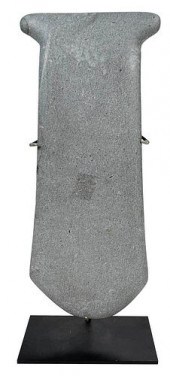 LARGE LATIN AMERICAN STONE AXE
LARGE LATIN AMERICAN STONE AXE HEADpossibly Pre Columbian/Valdivian, T shaped hand axe carved from smooth gray stone with many darker inclusions on one side, with metal stand, 17 x 7 in. Provenance: The Estate of Peter H. Tillou, Litchfield, Connecticut Condition: slight scratching, crack and repair to top on one end, staining and abrasions to one side, wear to stand
LARGE LATIN AMERICAN STONE AXE
LARGE LATIN AMERICAN STONE AXE HEADpossibly Pre Columbian/Valdivian, T shaped hand axe carved from smooth gray stone with many darker inclusions on one side, with metal stand, 17 x 7 in. Provenance: The Estate of Peter H. Tillou, Litchfield, Connecticut Condition: slight scratching, crack and repair to top on one end, staining and abrasions to one side, wear to stand -
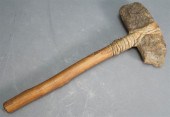 PLAINS INDIAN STONE AND WOOD HANDLE
PLAINS INDIAN STONE AND WOOD HANDLE AXE, 19TH CENTURYPlains Indian Stone and Wood Handle Axe, 19th Century
PLAINS INDIAN STONE AND WOOD HANDLE
PLAINS INDIAN STONE AND WOOD HANDLE AXE, 19TH CENTURYPlains Indian Stone and Wood Handle Axe, 19th Century -
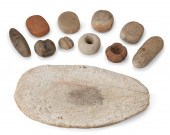 A GROUP OF STONE IMPLEMENTSA
A GROUP OF STONE IMPLEMENTSA group of stone implements, Pre-historic or later Comprising a group of carved stone objects including ax heads, net stones or sinkers, a mortar or paint pot, and a flat mortar and oval grinding stone, 11 pieces Dimensions: Largest: 1.25" H x 17.25" W x 10" D; smallest: 2.25" H x 2.5" W x 1.5" D
A GROUP OF STONE IMPLEMENTSA
A GROUP OF STONE IMPLEMENTSA group of stone implements, Pre-historic or later Comprising a group of carved stone objects including ax heads, net stones or sinkers, a mortar or paint pot, and a flat mortar and oval grinding stone, 11 pieces Dimensions: Largest: 1.25" H x 17.25" W x 10" D; smallest: 2.25" H x 2.5" W x 1.5" D
...many more examples with full details are available to our members - Learn more


